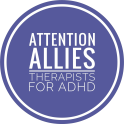Get ready to find some direction. Counsellor and creative therapist Rich Hayden suggests that ADHDers can be naturally drawn to work more comfortably in therapy with some flexible systems, structure and the use of all forms of creativity. Engaging our “right brain” in this way might eventually help us to find peace and harmony in the way we operate.
(5 minute read)
If you have ADHD, one of the things you’ve probably struggled with the most is being different. It’s fairly obvious that you think/feel/act differently from most other people around you.
Let’s just get the self-disclosure part out of the way: I’m a therapist and I have ADHD – something I didn’t figure out until later in my life.
Being different really is a double-edged sword; in part you have some pretty sharp abilities that neurotypicals don’t have, but it can also leave you feeling lonely, isolated and complicate your understanding of who you are.
“I’d like to be able understand myself better” is a common phrase I hear from almost every ADHD client during our first session when I ask what they would ideally like to get out of the therapy process.
I recognise how important it is for ADHDers to have a sense of direction in therapy. Otherwise the opportunity to wander off at a tangent, or get lost completely presents itself all too often! A sense of direction also helps clients to trust the process and feel they have ownership of their journey.
Over the years, I’ve become aware that people with ADHD seem to respond more positively to therapy that has a defined framework, system or pathway that can be used to “map out” or inform their direction. I’m thinking particularly of those I’ve worked with using the basis of the IFS (Internal Family Systems) framework.
The simple principals of IFS are that we each have a true self (spirit, soul, core) and a collection of other parts, which together make up our whole self. Our parts express themselves through our thoughts, feelings and behaviours.
I’ve been pondering why it is that people I’ve worked with who have ADHD seem so drawn to enjoying a system or a framework so much. Well, the obvious answer is structure! But a basic structure – one with not so much defining detail it becomes completely rigid; this would simply not be appealing to the ADHD mind!
I also think us ADHD-ers are drawn towards systems thinking because our brains just love the opportunity to spread out into mind map-type scenarios, with defined networks and plenty of potential for malleability and added detail. There’s the obvious attraction to a system from some common ADHD traits too: obsessive thinking, hyper-focus and what I call “need to know” curiosity.
When you’re the kind of person who simply needs to know either the correct answer, truth or end result of something and you’re given a system to work with (better still a system like IFS that explains thoughts, feelings and behaviours) your brain laps up the opportunity to spread out, be insanely curious and obsess over the something in question until the answer is found. Add in hyper-focus to find new pathways, networks and, of course, add details and… Houston we have lift-off!
From working with ADHD clients, I’ve seen how creative work forms an essential part of the process alongside IFS. The invitation to the client is to explore each of their parts through some form of creative medium (pens, paint, moulding clay, music, words, movement, sand tray, visualisation, literally anything creative!).
By using whatever creative medium the client feels drawn to, we allow their creative process to activate. In creative “mode”, we are accessing right brain (unconscious memory) and bringing it into conscious awareness. In essence we’re making ourselves aware of what we already knew, but weren’t previously aware of.
Through getting to know our individual parts and developing a relationship with them, we are able to practise unblending from them to a place of true self awareness. This creates distance between parts and our true self, so that we are far less affected by their actions and therefore able to work with them.
As clients get into the therapy structure and begin to work creatively with the different parts of their ADHD selves, the parts begin to develop their own individual characters. As awareness grows, each part’s traits and voices become more distinct and clients are able to have direct dialogue with them.
Over time, and with work, we can gain the trust of our parts and relieve them of their less helpful duties. All of this results in the self having more awareness of, and control over, the internal human operating system. Or, to put it another way, a better understanding of who you are, bingo!
Like I remind so many of my clients, how you are isn’t wrong just because it’s different! By accepting, understanding, working with and managing the ADHD parts of you in ways that make sense to you, it is possible to have a better relationship with yourself and find peace and harmony in the way you operate.
Click the links if you'd like to visit Rich's therapy website or hir directory entry on Attention Allies.
Published 1 September 2024
All rights reserved © Copyright Rich Hayden 2024. Unauthorised use and/or duplication of this material without express and written permission from the author of this post is strictly prohibited. Author contact via website Contact page.
Website version and image © Copyright Attention Allies 2024.
